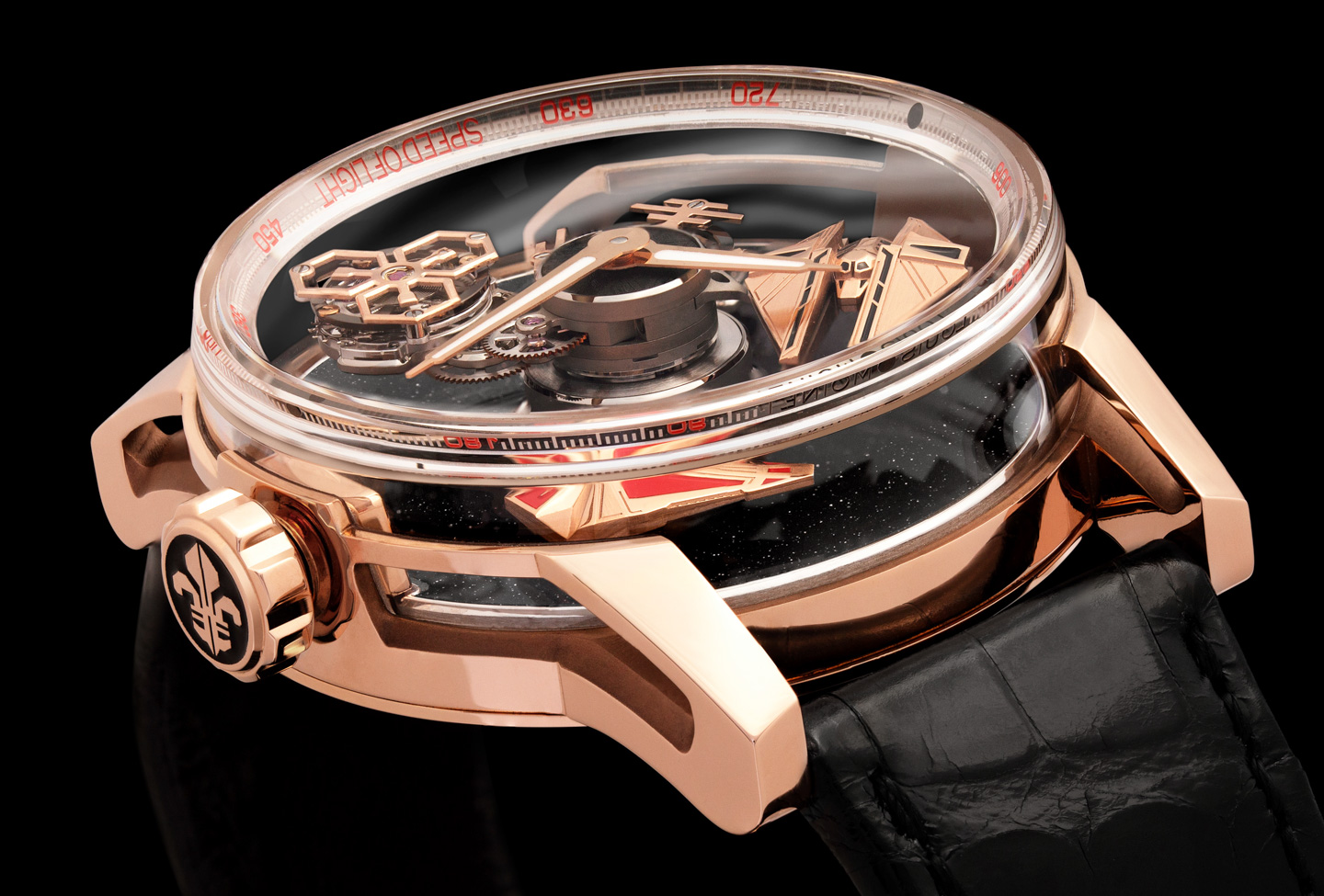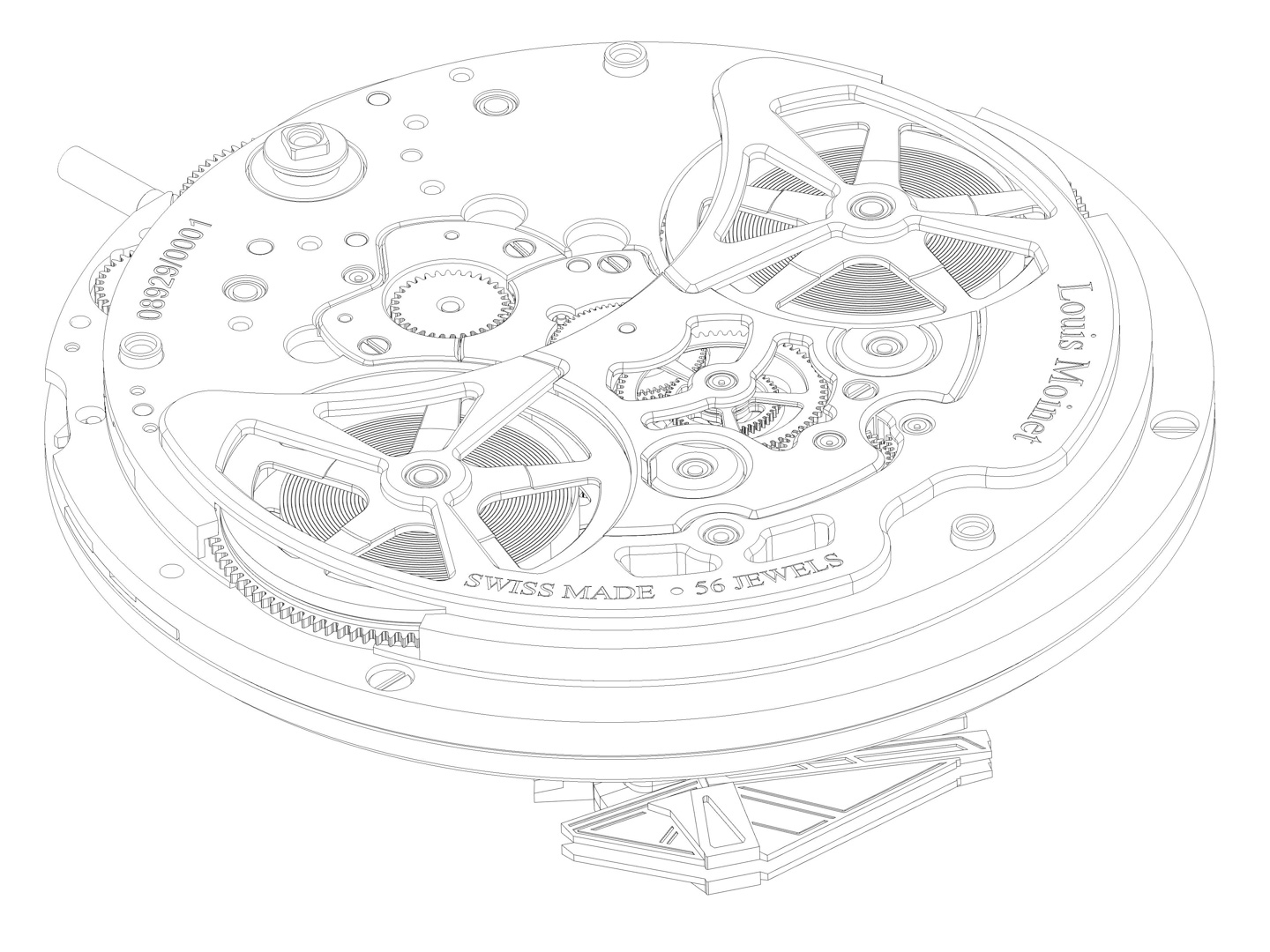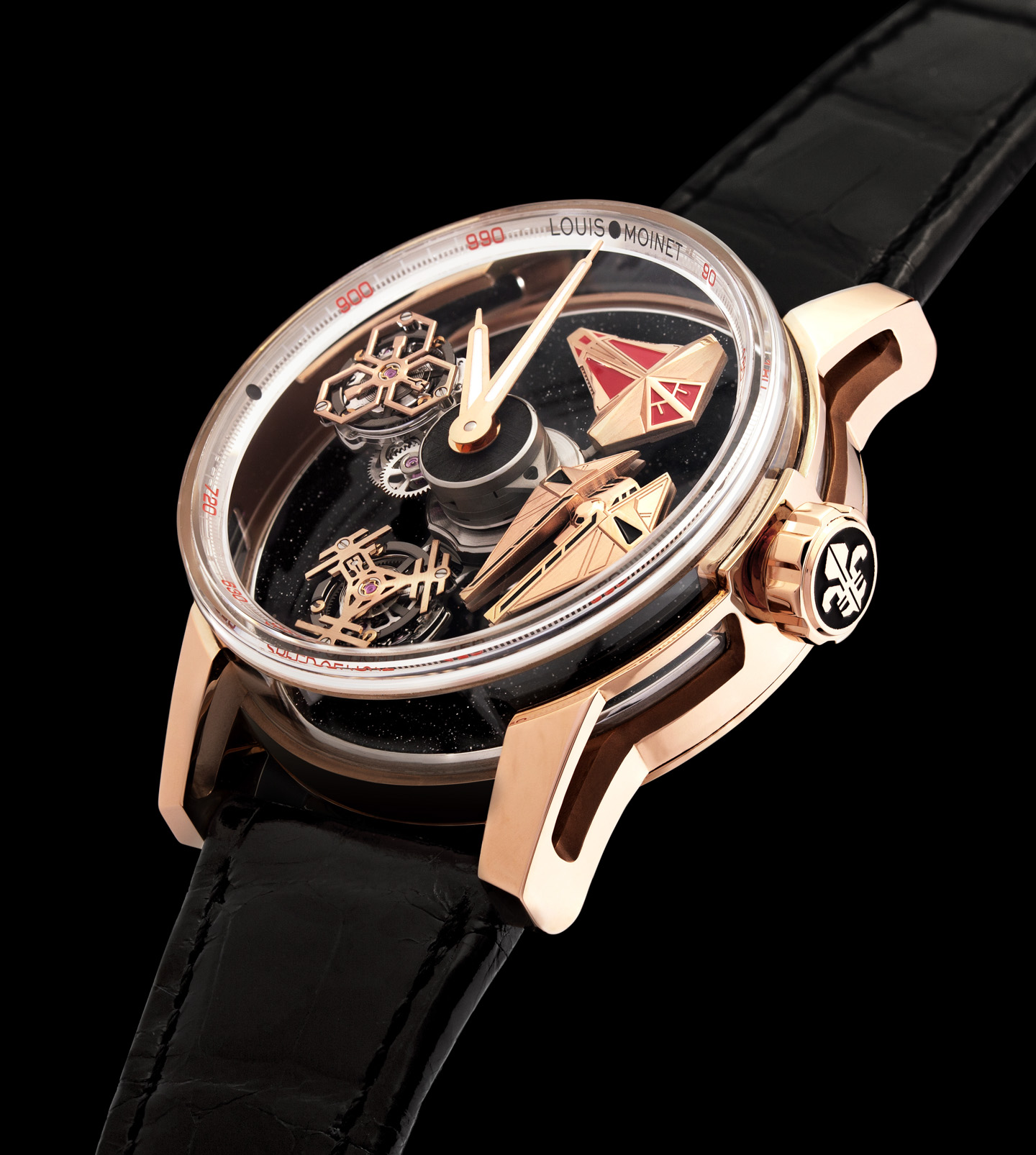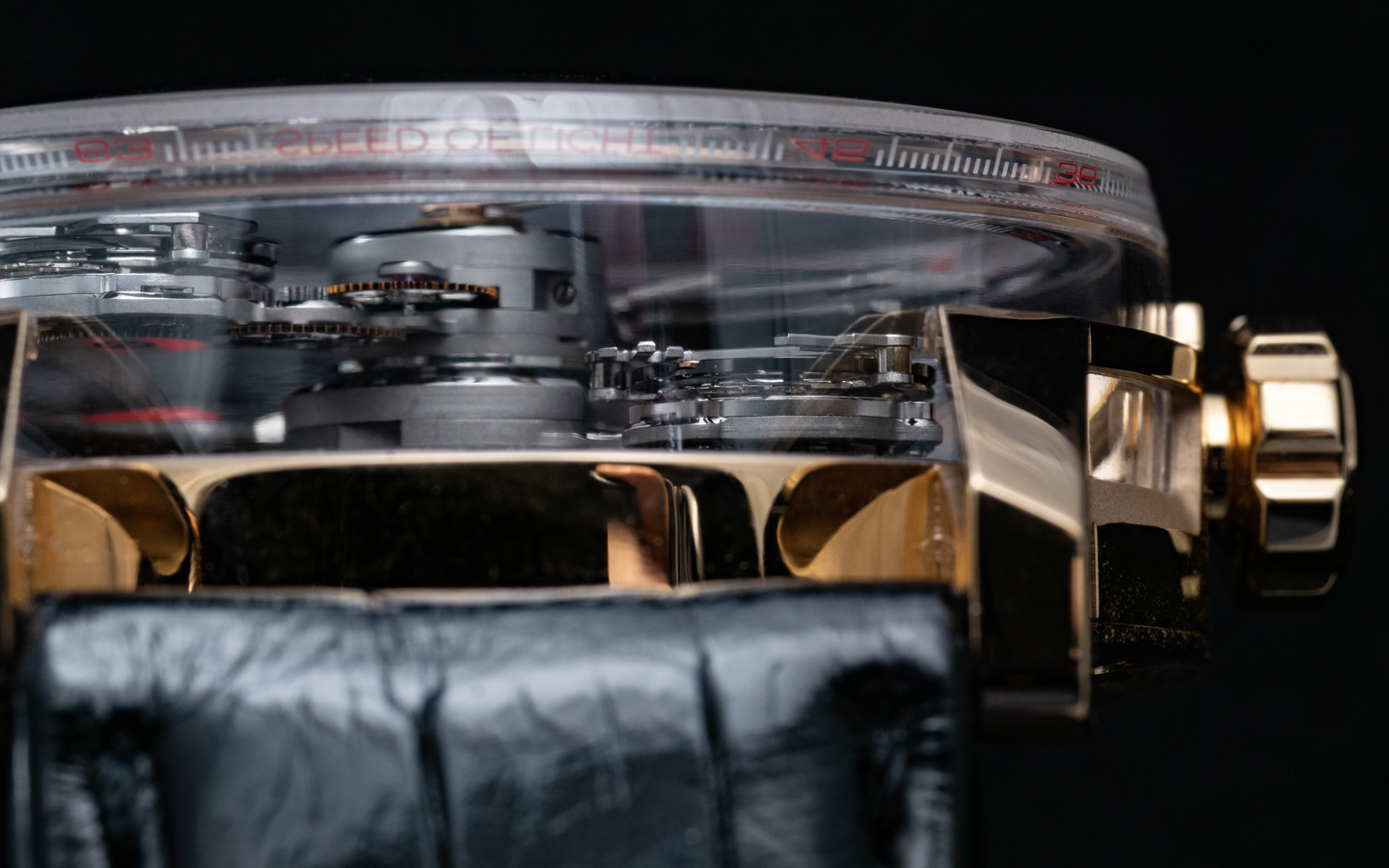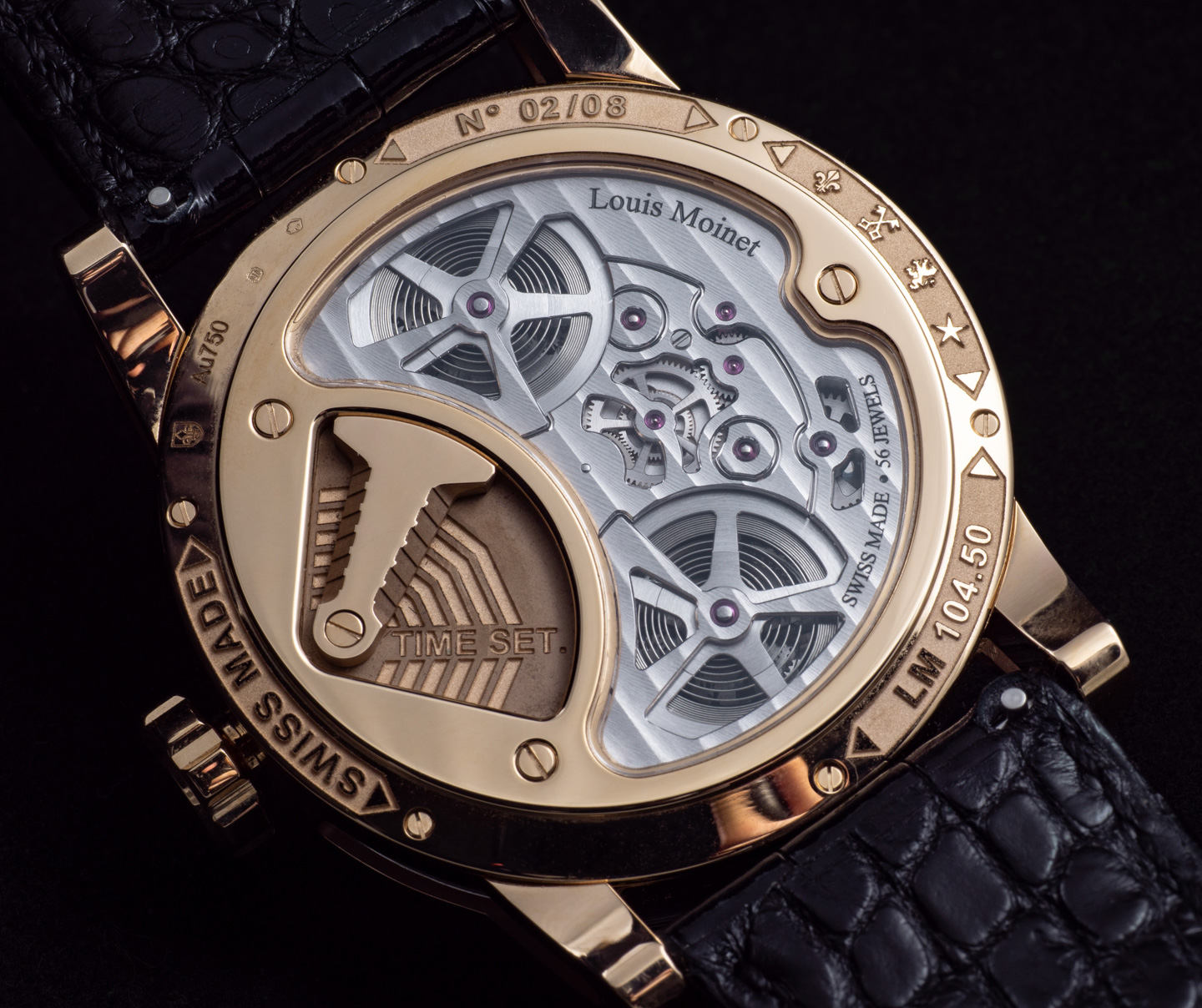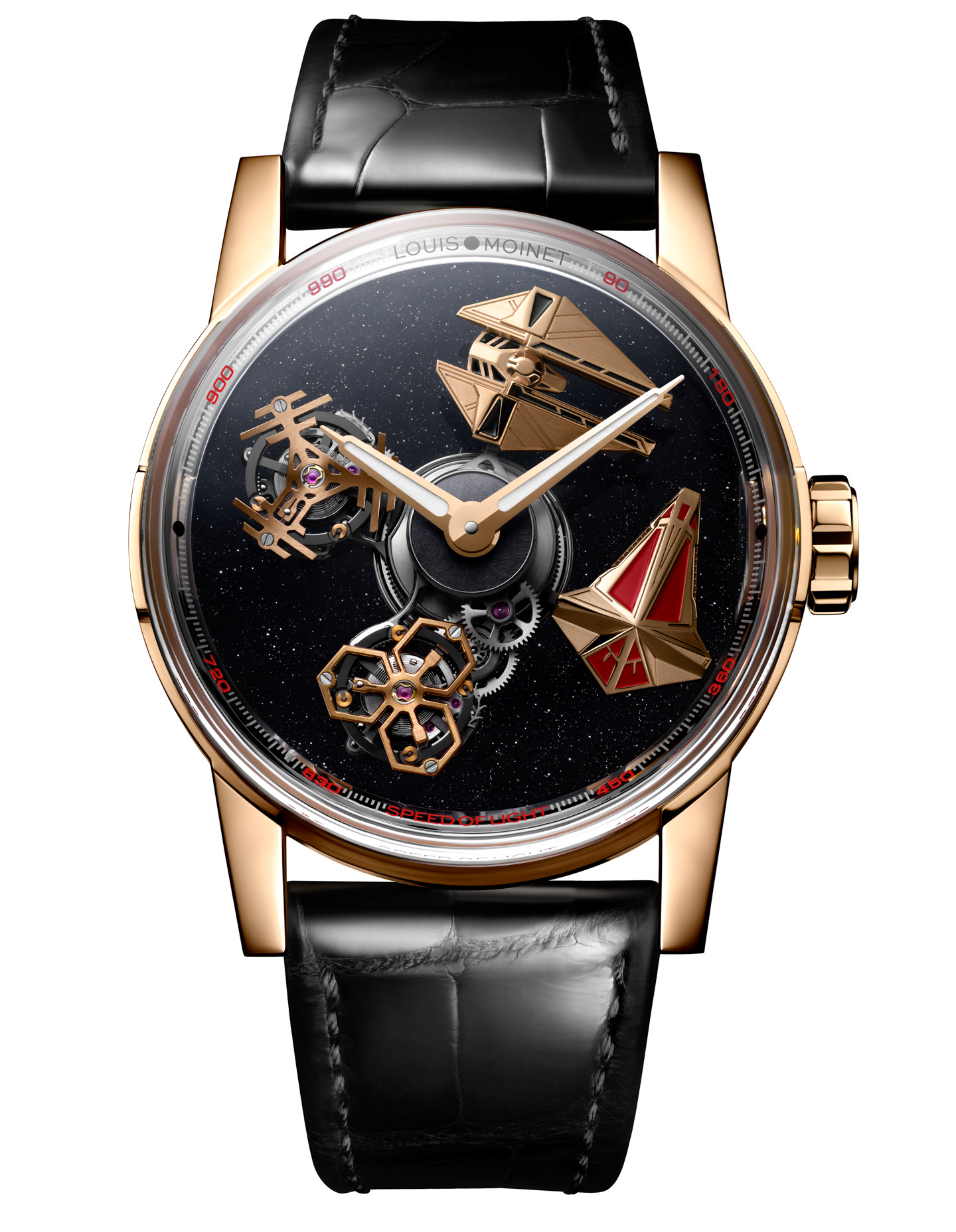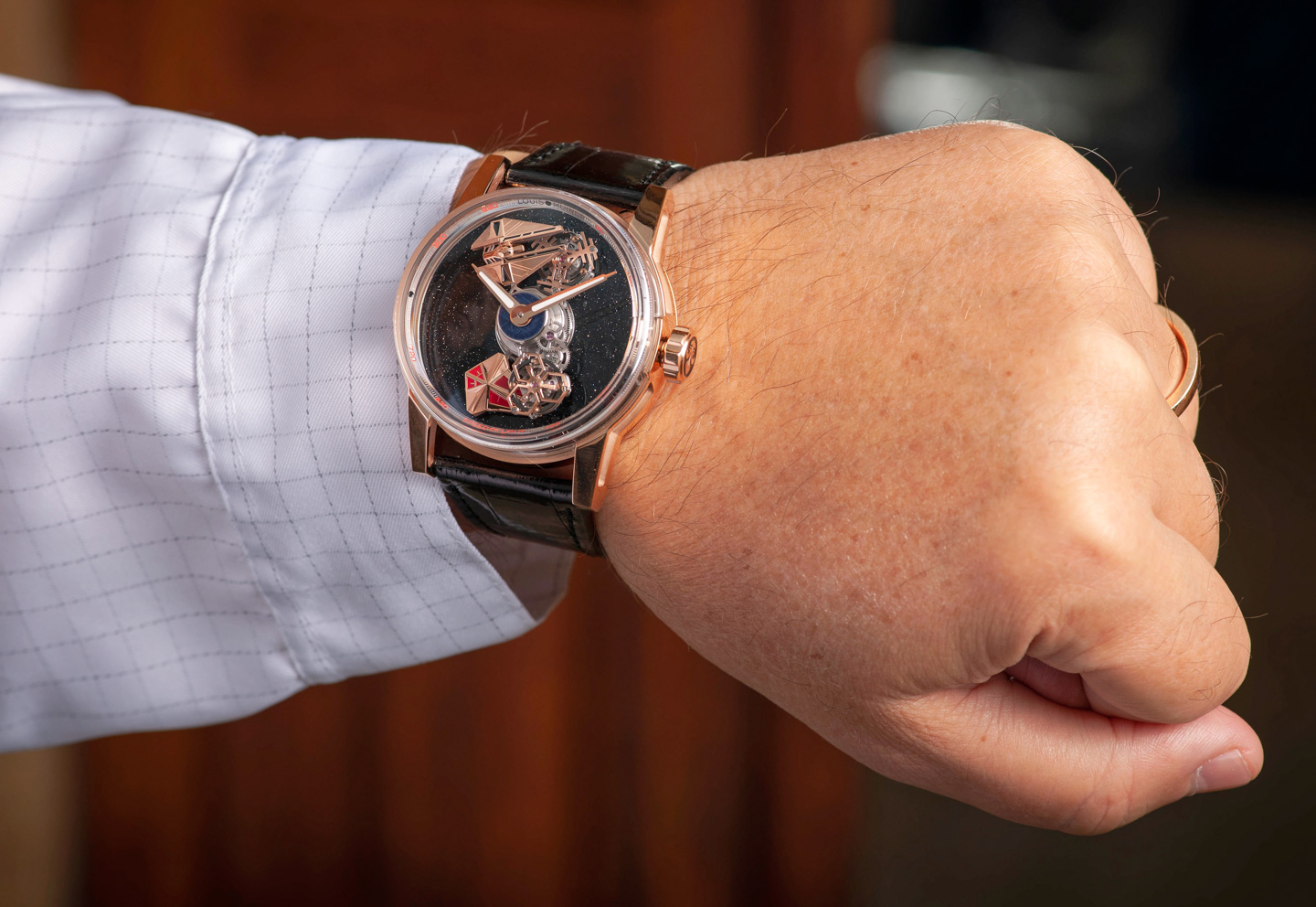
The “independent watch movement” that began in the early 2000s was defined by a marked deviation from horological style norms of the past. This time period is what I call the second-wave of modern luxury timepieces because it focused on wearable mechanical art more so than producing contemporary luxury timepieces that were fashion and/or jewelry in their focus. Some of these wearable art watchmakers devised brand new names (such as Christophe Claret, Urwerk, and MB&F), and others resurrected old names as a means of creating a thematic framework around truly modern timepieces that also fit the “mechanical wrist art” category. Among those companies was Louis Moinet, a famed historic watch brand that invented the chronograph more than 200 years ago.
“Independent” as a term applied to watch brands today is highly ambiguous. What people tend to refer to is independence of thought when it comes to design. There are those watchmakers who apply the past in designs for today, and there are those mavericks of horology who use technologies of the past to create novel products. Many of these companies, almost out of low-production-level necessities, are forced into the high-end market, the implication being that their ornate mechanical timepieces — often with new inventions and always with fresh visuals — are priced for consumers at the top end. Fine art rarely comes with accessible pricing, and thankfully, there is a robust community of top-level timepiece collectors who savor in the “wow effect” that brands like Louis Moinet and colleague companies are able to produce with many of their original designs.
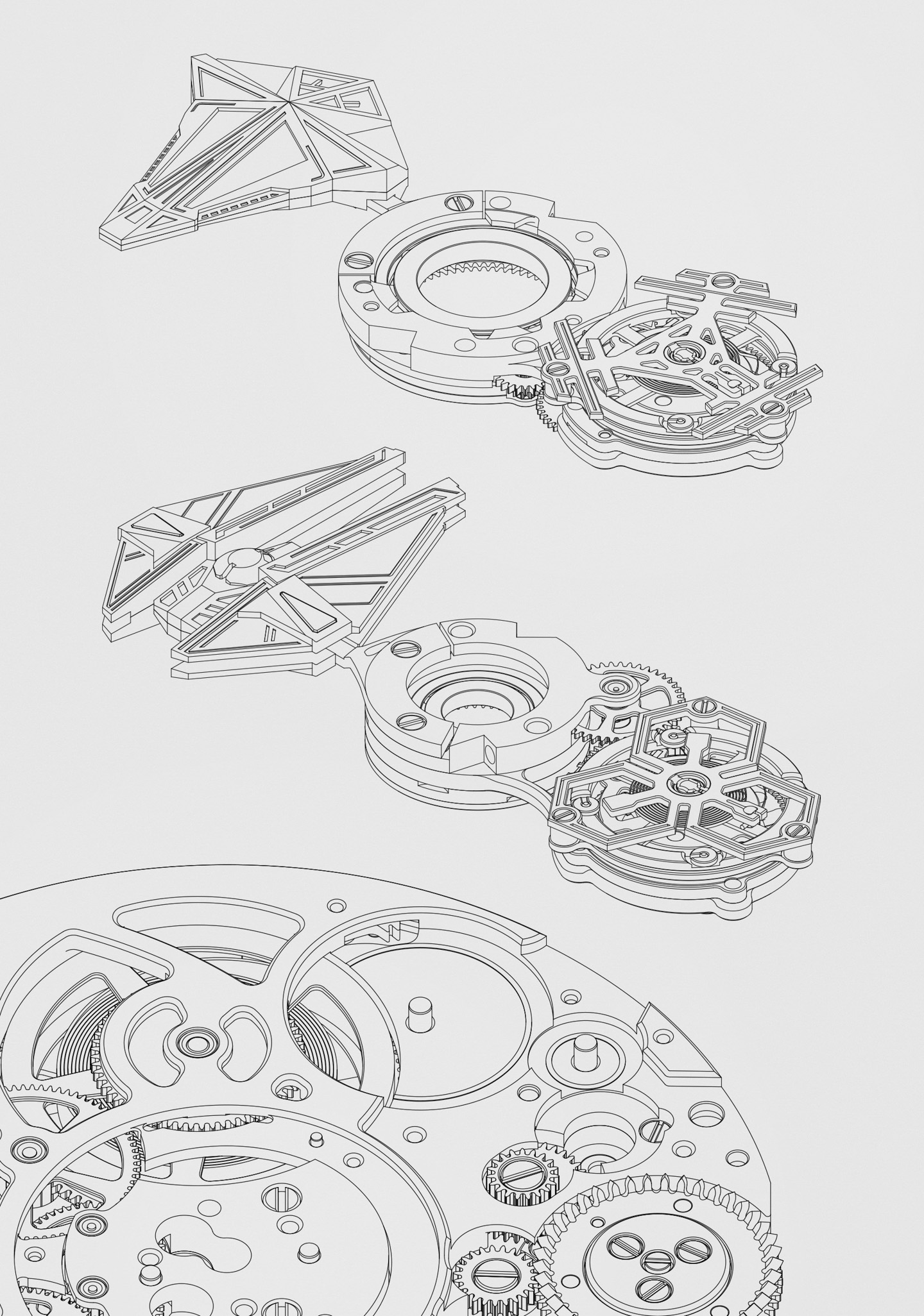
Louis Moinet is headed by Mr. Jean-Marie Schaller, whom I interview below about the Space Revolution watch. For a while now, Louis Moinet products have been highly focused on space and celestial objects, but the Space Revolution extends the theme into a new and popular area of inspiration for high-end watchmakers: science fiction. Mr. Schaller wanted to discuss some of the Space Revolution watch story with the aBlogtoWatch audience. But first, allow me to remind you about our prior hands-on aBlogtoWatch coverage of the Louis Moinet Space Revolution watch.
The Space Revolution watch is thoroughly part of the mechanical wrist art product family. While the timepiece does indicate the time, the theme of the piece, overall, is a mechanical representation of what cinema has coined a “space ballet” with science fiction ships battling about science fiction themes. The movement has a planetary arm system that has revolving objects (including two tourbillons) animate the view of the dial each time the wearer glances at it. Louis Moinet has been producing effective “conversation” watches for well over a decade now, and the Space Revolution watch simply extends that concept even further. Louis Moinet didn’t design a watch to appeal to all contemporary tastes. Rather, it created a watch that successfully and elegantly advances a mechanical art theme, and for that it will eventually be grandly celebrated, along with similar objects, when more enthusiasts understand the intentions behind wonderful mechanical luxuries such as this. Now, here with more about the development of the Space Revolution watch, is Louis Moinet’s Jean-Marie Schaller:
 aBlogtoWatch: Celestial watches have a deep history in horology because timekeeping, as we know it is for the most part, is based on our observations of the sky. Can you talk a little bit about how you try to incorporate this history of timekeeping as part of your stewardship of Louis Moinet, a historic name in watch keeping?
aBlogtoWatch: Celestial watches have a deep history in horology because timekeeping, as we know it is for the most part, is based on our observations of the sky. Can you talk a little bit about how you try to incorporate this history of timekeeping as part of your stewardship of Louis Moinet, a historic name in watch keeping?
Jean-Marie Schaller: The relationship with the sky goes back to the roots of Louis Moinet, at a time when he invented the chronograph to improve his astronomical observations. He conceived of this device in 1815 and it took a year to be made by hand. He named it a compte-tierces.”
Why? Because a “tierce” corresponds to one-sixtieth of a second and, back then, was the astronomical unit graduating the lens of his telescope. To measure the transit of the stars, he needed to keep an eye on the celestial body and, at the same time, keep a free hand to activate his new time invention. The compteur de tierces turned out to be the first chronograph, as well as the first high-frequency watch, and is now the recipient of two Guinness World Records!
On a more recent horizon, the friendship with Luc Labenne, one of the world authorities in terms of meteorites, enabled me to create Meteoris (2014), a spectacular planetarium with the very first watches featuring genuine Moon and Mars meteorites. Since then, I have taken the habit to spend long hours brainstorming with Luc, and today, my meteorites collection exceeds 25 different types, many of them not for sale. Meteorites remind me of the infinite universe, and our relationship with time. They all have a different story to tell us: some of them are older than the Earth itself, others contain amino-acids, the blocks of life.
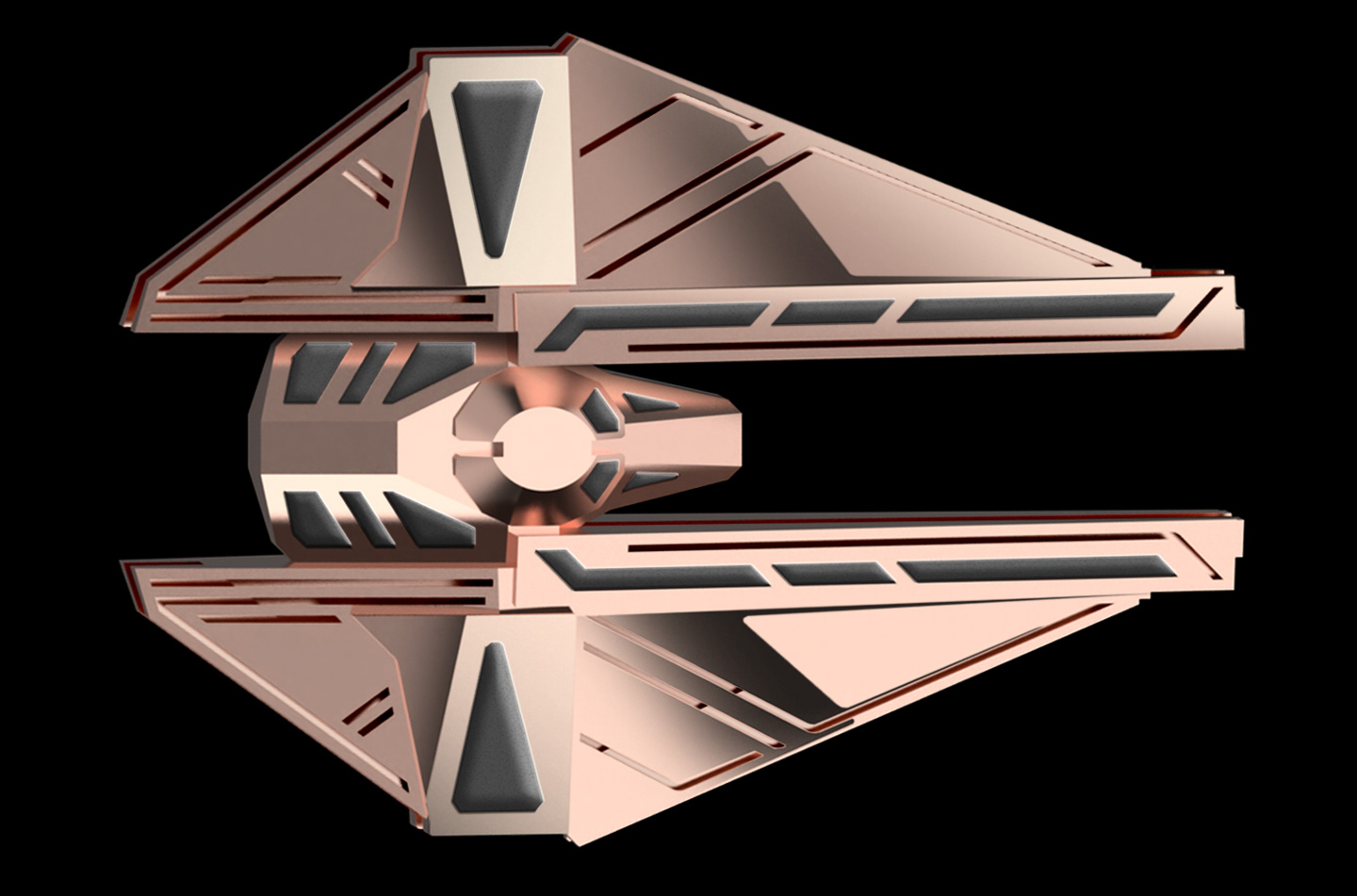
aBlogtoWatch: Louis Moinet products have, in large part, been defined by connections to space, planets, and our celestial bodies — mostly in terms of theme and materials. Talk a little bit about how the Louis Moinet brand developed into a creative house for space-themed emotional timepieces.
Jean-Marie Schaller: During his life (1768 – 1853), Louis Moinet was considered one of the most important watchmakers. At a time when Paris was the world capital of watchmaking, his friend Abraham-Louis Breguet used to introduce him as “the best watchmaker in Paris,” after him… Louis Moinet was also a secret and mysterious man. He dedicated all his life to his passions — watchmaking and astronomy — and never was a marketing man.
Twenty years ago, his name was almost completely forgotten, even though various episodes lead me to think that destiny was calling me; I felt I had a mission to continue his work, to make him known again. I decided to put all my efforts into the writing of the second chapter of Louis Moinet. However, this emotional feeling was counterbalanced by the fact that I had nothing in my hands except an eight-page biography written when he passed away. I was a blind man, trying to guess which path I should follow. The Internet helped me to find some major creations of Louis Moinet, such as the Thomas Jefferson and James Monroe clocks, the latter of which is still being exhibited at the White House. I soon discovered that other customers included Napoleon, the King of England, the King of Hanover, the King of Naples, and Tsar Alexander the First of Russia. Wow!
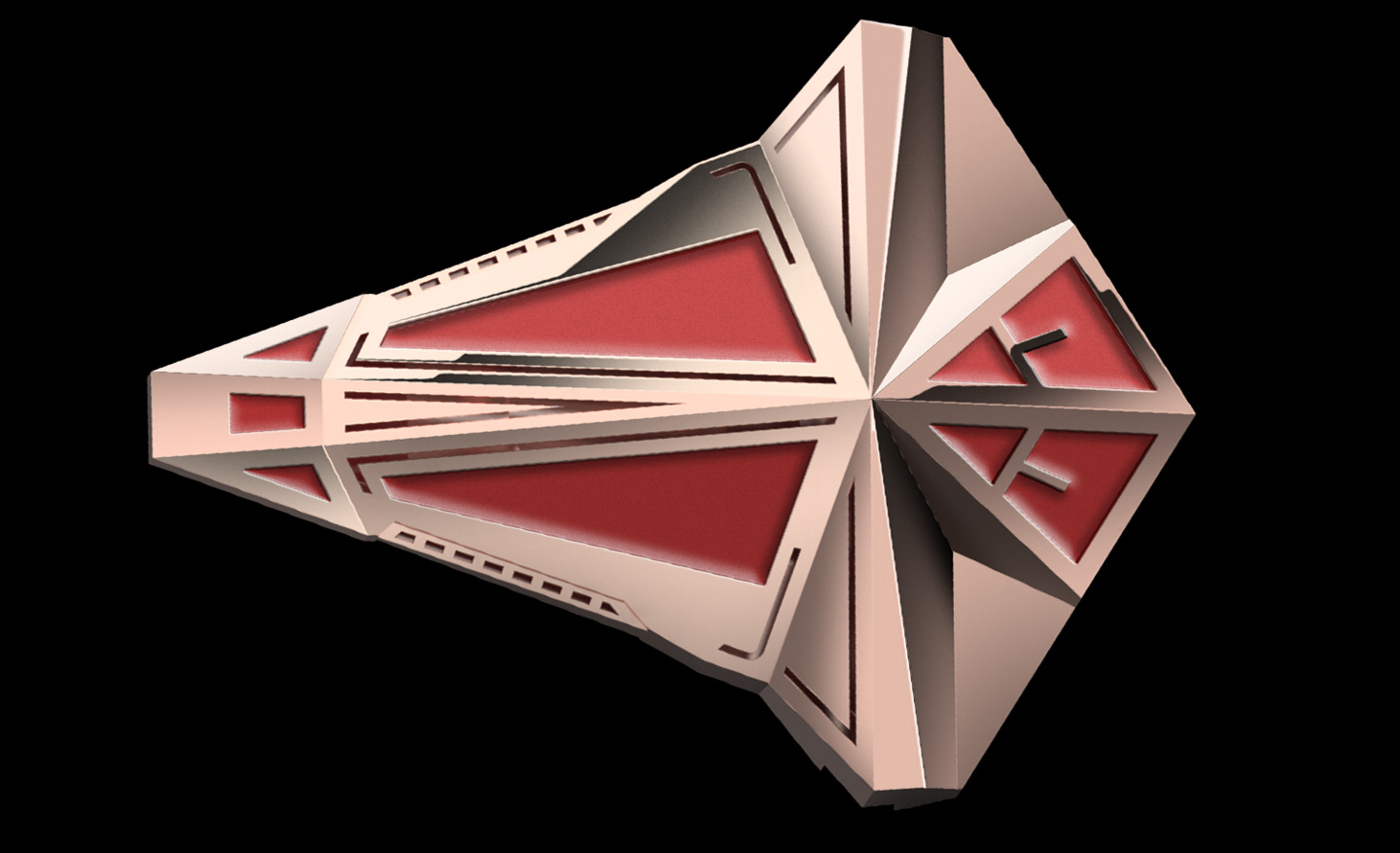
When I worked on the first creations, I was immediately attracted by the celestial world. Therefore, we created mechanisms and emotions linked to this theme. Earlier this year, for instance, I have introduced a concept called MOON RACE, featuring genuine flown materials from the most important American and Russian moon missions. All four watches are decorated with authentic fragments from Apollo and Luna that traveled half a million kilometers in space!
Today, our collections are based on two pillars: Mechanical Wonders and Cosmic Art. The first one focuses on a pure technical soul, whereas the second one emphasizes celestial functions, bodies as well as flown materials and cooperation with leading astronauts and cosmonauts.
As a personal comment, I feel very happy to have taken this road during the « blindness » years. Now that we know the story of Louis Moinet better, we can say that the second chapter is in line with the first one!
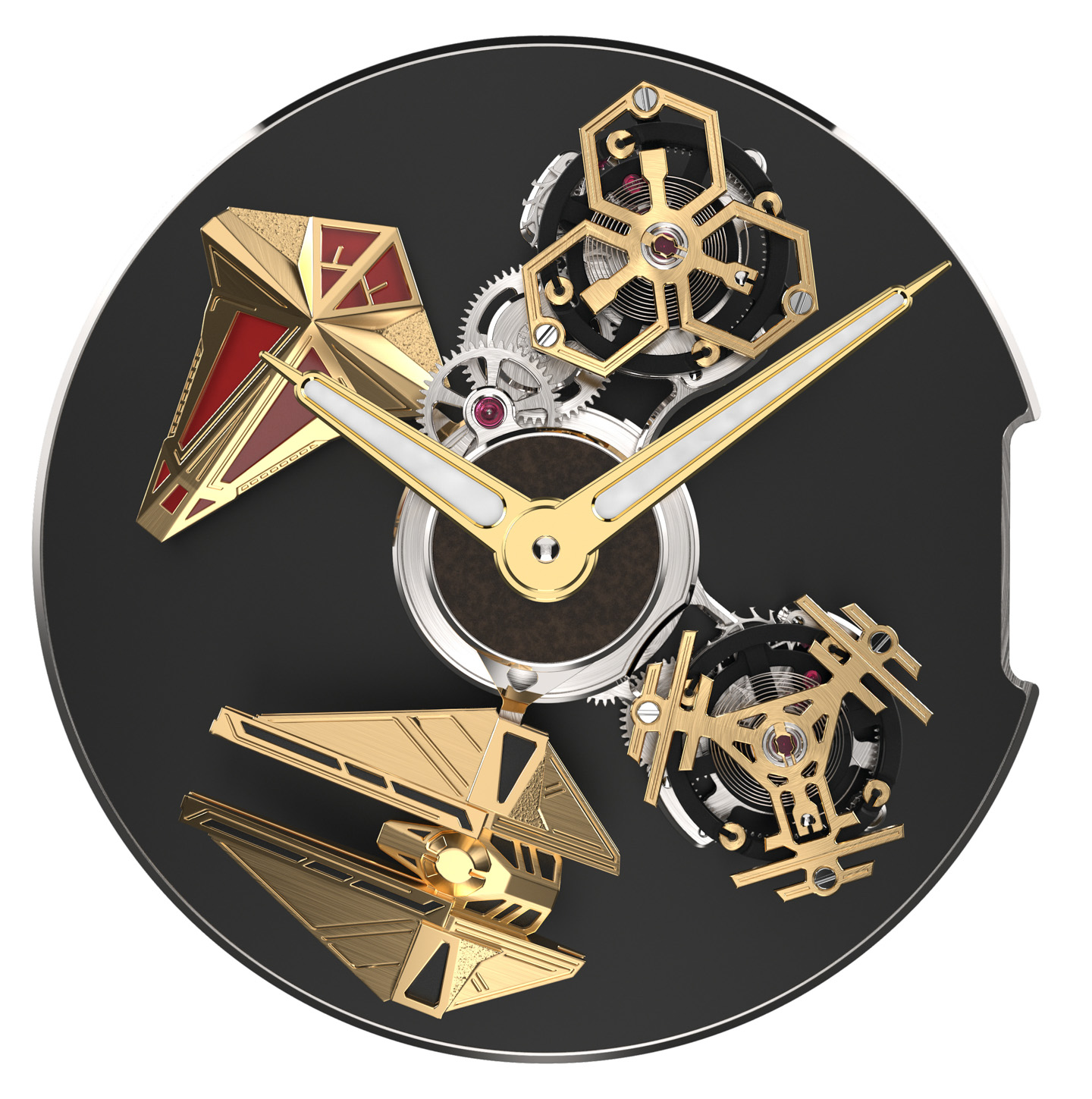
aBlogtoWatch: What are some of your personal “grail” materials, or complications that ideally celebrate in your mind how a luxury watchmaker like Louis Moinet can create beautiful objects as well as those that have deep emotional connections with their owners?
Jean-Marie Schaller: You are right, it is all about creating beautiful objects conveying a new emotion. For instance, I worked for more than a year on a minute repeater concept, to finally drop the project. Why? Because I could not find enough substance to make it unique. I believe there is no point in reproducing what already exists. We need to be genuine, animated by an artisan and innovative soul, exactly like Mr. Moinet 200 years ago. A watch needs to have its own character, different from others. Space Revolution is the perfect example. This watch incorporates three world firsts thanks to a special technology. On the road, we faced many challenges and there were days when we thought we would not make it. But our fuel was always love, and never fear.
I like space-related materials because they give us a bigger vision. The first time I observed Mars from a 100-year-old telescope gave me goose bumps. I realized how much I was a small part of such a big world. It also gave me a good perspective on the human relationship with the environment.
Looking at meteorites, there are fabulous little fragments traveling alone in the universe for millions of kilometers to finally become shooting stars when captured by Earth’s attraction. Their second life begins in the hands of the best artisans, who give a unique emotion to the one who chooses them. I see this as a philosophical cycle being accomplished.
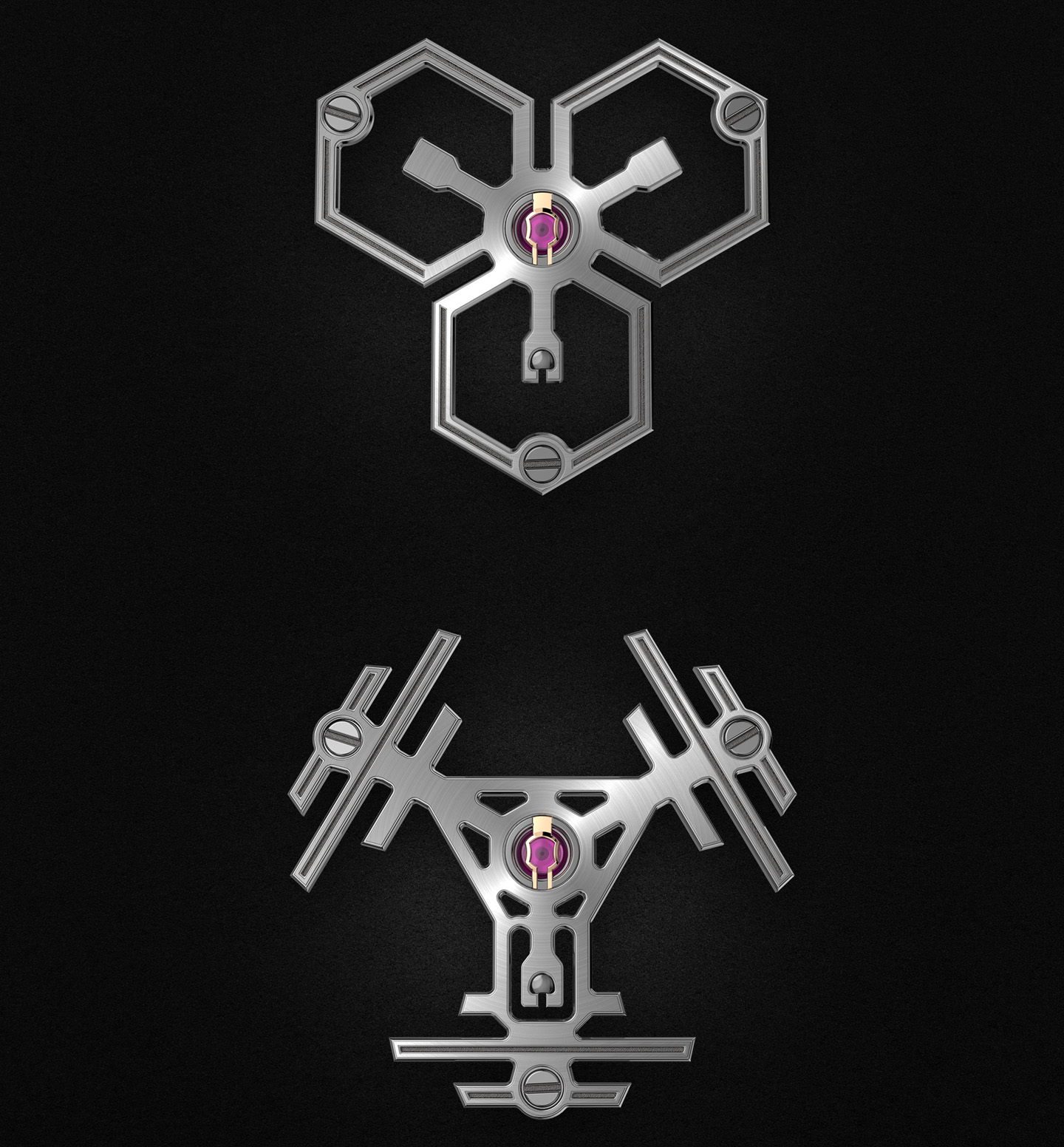
aBlogtoWatch: In recent years, the celebration of space-themed luxury watches has begun to incorporate pop culture elements ranging from real-life space flight to interstellar fantasy. Talk about some of the design and creative possibilities available today, that just a decade ago might not have seemed palatable to consumers given changing tastes. In general, also talk about some of the creative possibilities now open as the subject of space-themed watches has never been grander.
Jean-Marie Schaller: Space has become a very important human quest. American and Russian leaders have opened the door to a new “space race.” Today, the world counts more than 70 different government space agencies. Many of them have already undertaken major projects. And of course, private missions are now part of the race.
All this has opened a new world of fantasy, at a time when micro-technology enables traditional watchmaking to go beyond new frontiers. What was considered impossible is now feasible thanks to miniaturization and technological innovations. New materials also play an important role, such as high-tech ceramic ball bearings or silicon.
One of the most important qualities is to remain genuine and true to oneself. Look at the work accomplished by some watchmakers around this theme, and you will agree that they have developed their own vision. This is what matters! Everyone has to find their proper road.
My idea has always been to create values and unity for our customers. Where else can they find the rarest meteorites? Let’s share a scoop: Soon, we will introduce a new creation called ONLY INDIA. Two years ago, I conceived a watch named ONLY MEXICO. It features the oldest known fragment from the Solar system, the Allende meteorite that was found in Mexico.
The difficulty for ONLY INDIA was to create a watch at a similar level of attraction and exclusivity. After months of research, I finally found an authentic fragment of Shergotty, the meteorite that fell in India in 1865. Meanwhile, Shergotty became world-famous. It gave its name to one of the most important families of Mars meteorites.
Of course, the original Shergotty meteorite is extremely valuable, and I had the good fortune to discover what is most probably the only available fragment of it.
I had to be patient to pursue this quest. It takes time to identify the top specialists in the world, then establish a strong relationship with them. I only deal with a handful of them, as not many can provide the most incredible extraterrestrial and flown materials — not to mention that every selected piece has to be fully documented.
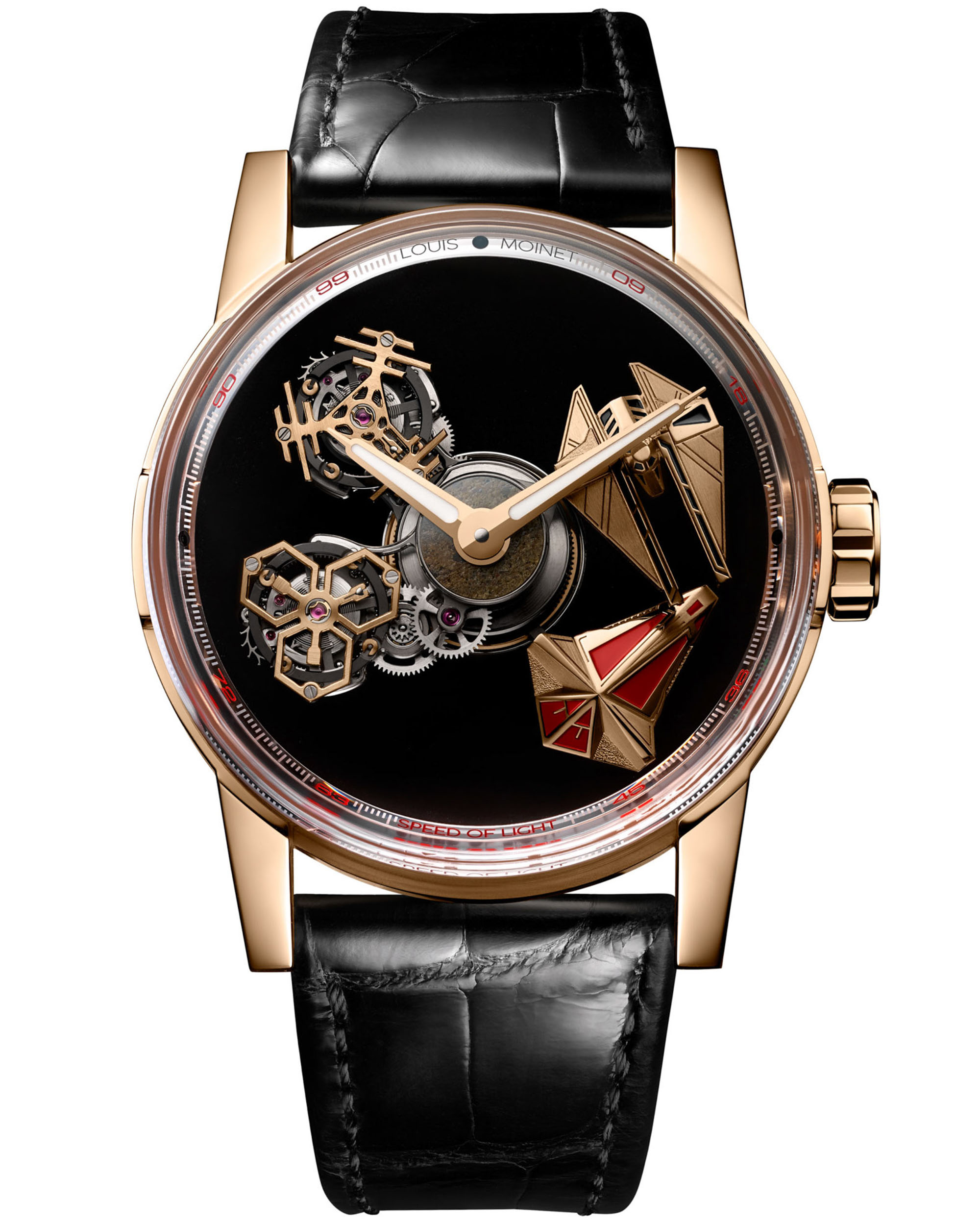
aBlogtoWatch: How did the genesis of the Space Revolution watch start? What was Louis Moinet trying to accomplish with the concept, overall, and how did it finally come to life in terms of how it works and what it looks like?
Jean-Marie Schaller: Space Revolution is art. The purpose of art is to bring of a new vision of the world. Its mission was to express cosmic art in the strongest possible way. That’s why I imagined two tourbillons rotating in opposite directions. Because I wanted them to be part of the concept, I designed cages that look like satellites rather than a traditional watchmaking expression. To express its power, the cages had to turn quickly, so we imagined a fast speed so you would see them constantly moving. This revolution speed became 5 and 10 minutes. We decided on two different speeds to add to the fun. And of course, they had to cross paths very often, therefore, to be built at two different levels.
Technical discussions started, and soon limitations emerged because such a concept did not exist before, and nobody knew how to make it work. “Can we do it?” “It will never work!” “It is much too complicated to be made…”
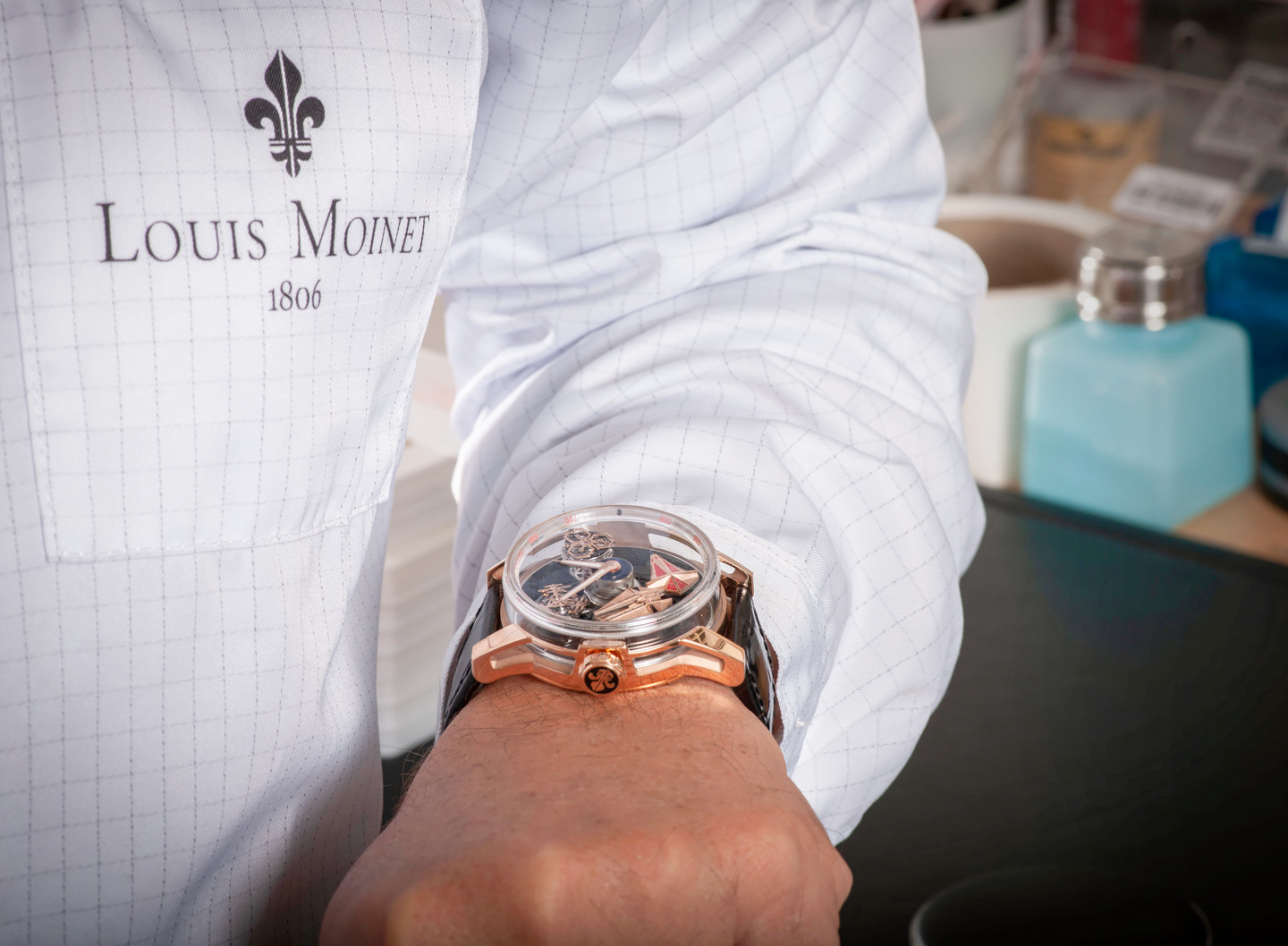
The only approach was to go step by step, and the engineer first imagined how to hide the mechanism in the bottom of the case, being as flat as possible. The challenge was met, and the height was limited to 3.75 mm for a twin-barrel caliber. Room was made for the show what was next? To convey the energy to the tourbillons. A high-tech central tower was imagined, with a total of 44 ceramic ball bearings and a few secrets in its sophisticated conception.
Tourbillon counterweights became spaceships, crafted in titanium and hand-finished. If their weight would exceed 0.5 grams, the system would not work perfectly. The perfect balance was to be found in micro-grams. The final result is a playful space odyssey. It took three years to overcome technical boundaries and express its powerful look.
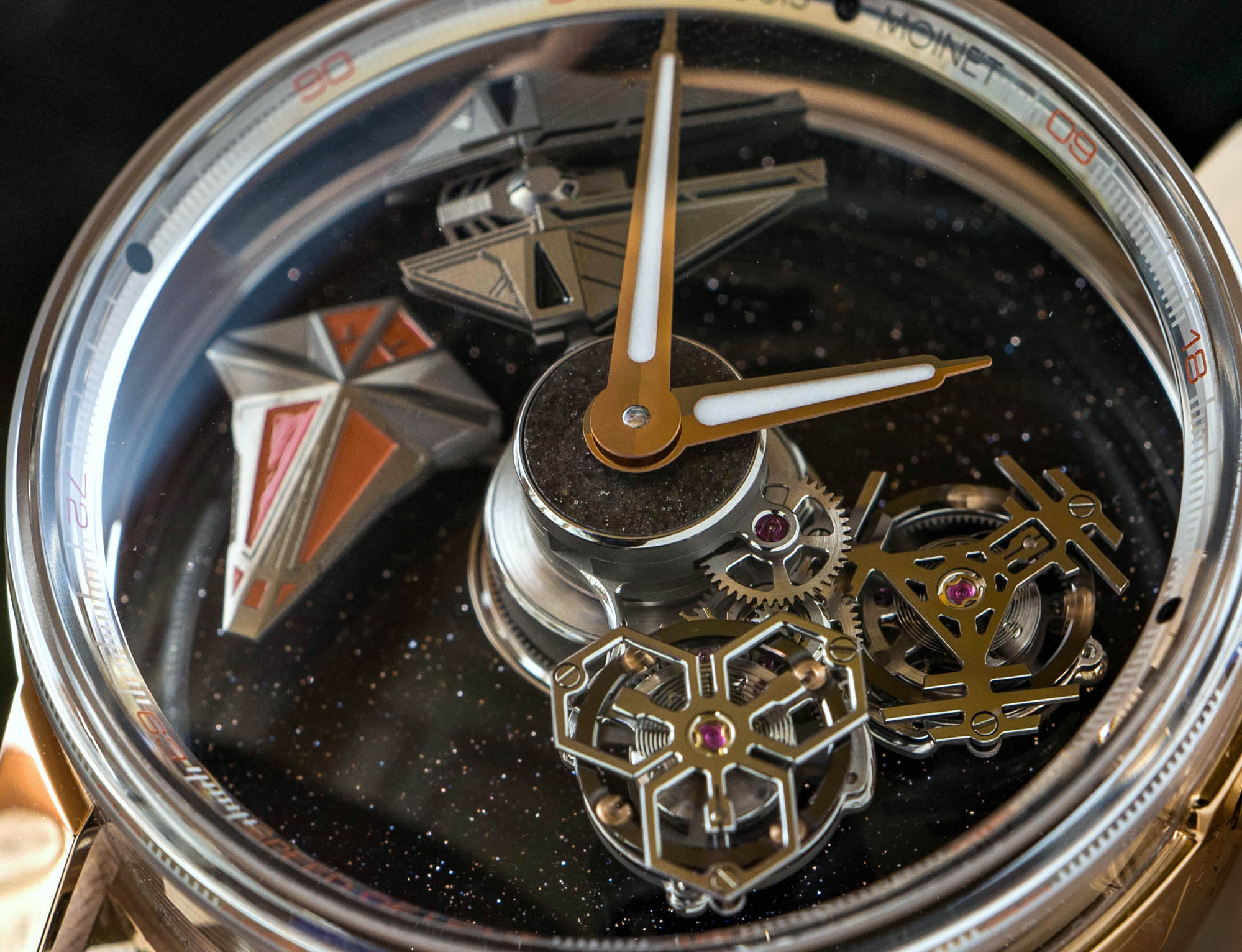
aBlogtoWatch: When you first showed the design to friends and consumers, what were some of the reactions to a Louis Moinet watch that was just as much about celebrating the optimistic fantasy of science fiction, as much as it celebrated timekeeping’s historic fascination with sky?
Jean-Marie Schaller: I think it is fair to say that they were surprised. I have noticed that the fascination grows when the timepiece is subject to close scrutiny. First, the observer looks at the space vessels and satellites, see them move under their eyes, and wait for the next encounter. They are very surprised to discover that a whole universe is moving inside the timepiece. In total, there are six elements constantly on the move: the two spaceships and the two tourbillons, which are rotating on their own axis as well as around the dial. Then the review leads to look deeper and find out that wearability is pleasant. In spite of its 470 components, the width is only 43mm and remains very light, thanks to its special construction. This is also a winner: you can enjoy the show from many different angles, as the watch features a gold chassis on which a sapphire container is mounted, allowing maximal viewing.
This visual perception enables us to quickly understand how the watch was conceived, with the hidden mechanism and its central brain, which is the tower. Finally, people notice the high quality of the black aventurine that was preserved for more than 50 years to be used today, at a time when real aventurine made in Murano is excessively difficult to be found. And of course, the exclusivity linked to the small edition – only eight watches — and the fact that each one of them features a different meteorite in its center, below the hands.
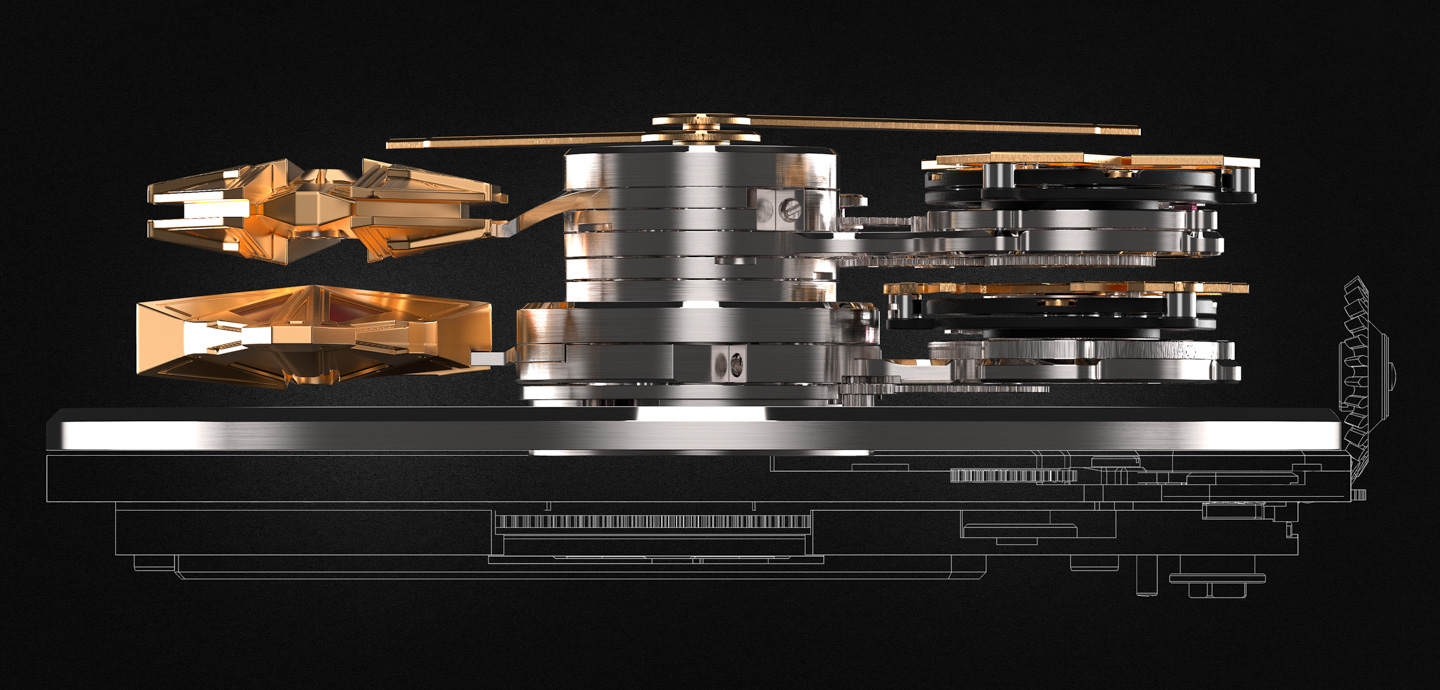
aBlogtoWatch: Are there any hidden technical stories or development challenges from the Space Revolution project that you feel the timepiece enthusiast community would find interesting to know about?
Jean-Marie Schaller: Actually the key was to keep the focus in spite of the accumulation of details. Everything has to be thought at the same time, to preserve a well-balanced creation. From a technical point of view, two barrels are needed, each of them transmitting energy to a tourbillon. The tourbillon cage must not weigh more than 0.24 grams in order to run well. The two tourbillons and spaceships will cross paths 18 times an hour, which means every three minutes and 20 seconds. They must be at the perfect height to avoid any collision. The size of the watch had to be 42 mm (finally it became 43 mm), and a central tower has to be built in a more compact way and, at the same time, include a differential system and five ball-bearings with seven ceramic balls as well as one ball-bearing with nine ceramic balls. To gain space, time-setting and -winding are made through a selector integrated into the caseback. Every small detail has to be in line with the plan, or it might destroy it.
Timing is also important, of course. The world has gone through a difficult period. When you work on a concept for so long, it becomes difficult to estimate the launch period. You cannot rush things; you must be patient to fully overcome challenges and come up with the right solutions. We did not know what to expect, but luckily, our friends and customers found Space Revolution very refreshing!
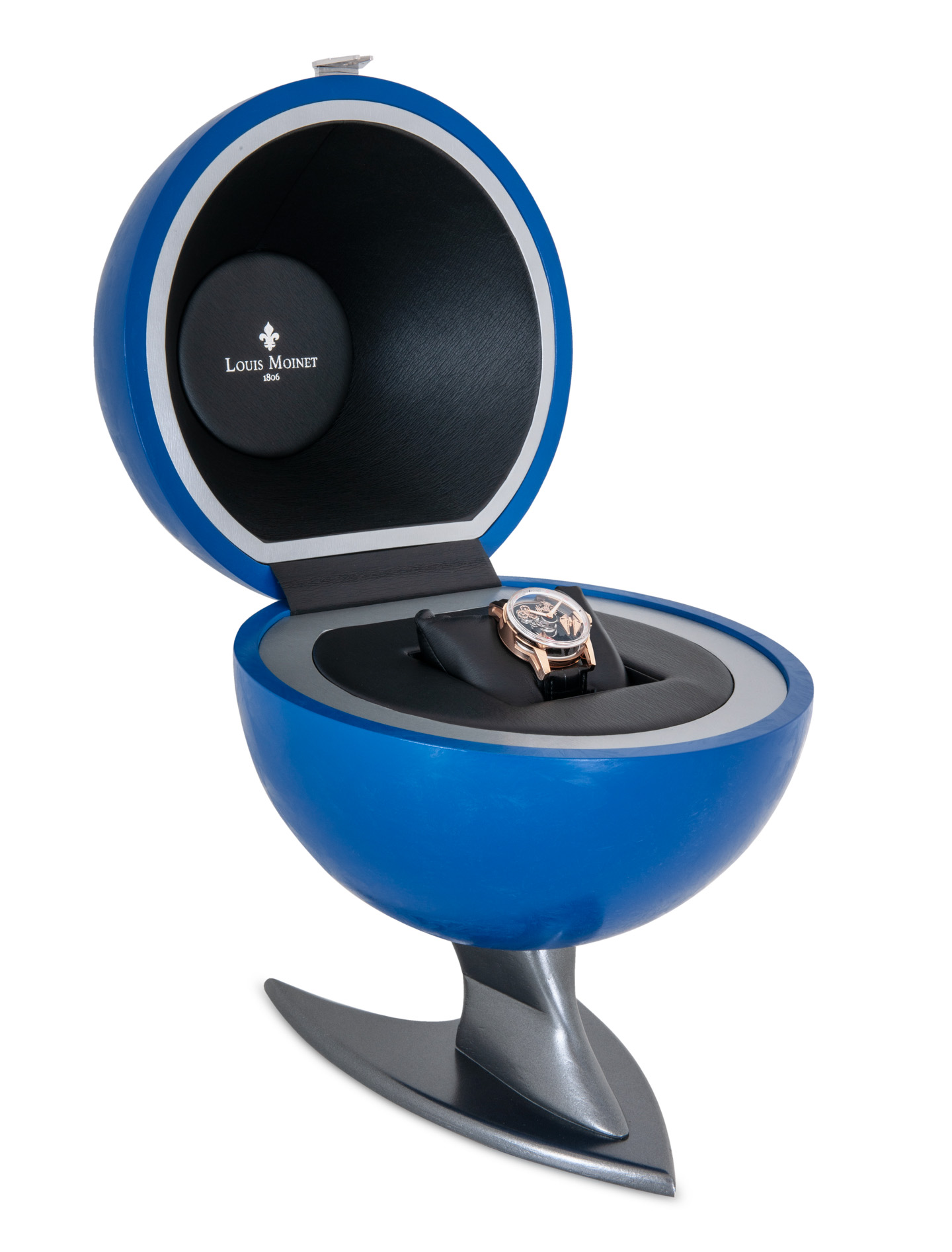
aBlogtoWatch: What positive lessons did you learn from the success of the Space Revolution watch that Louis Moinet will apply to future watch models and creative projects?
Jean-Marie Schaller: As you can easily imagine, Space Revolution is a major project for a small independent, in terms of time, resources and finance. To master this project is a great source of satisfaction. The fact that it won the “tourbillon of the year” contest at the recent Middle East Watch of the Year Awards proves that the market is appreciative of spectacular new creations and not only vintage watches, like many others propose.
The success of Space Revolution is based on our love for watchmaking and Louis Moinet at the same time. My vision is to open the doors of a new world and I am not fearful of being a small fish in a big pond. On the contrary, it enables me to remain true to myself with my own company, taking full decisions and responsibility for what I do.
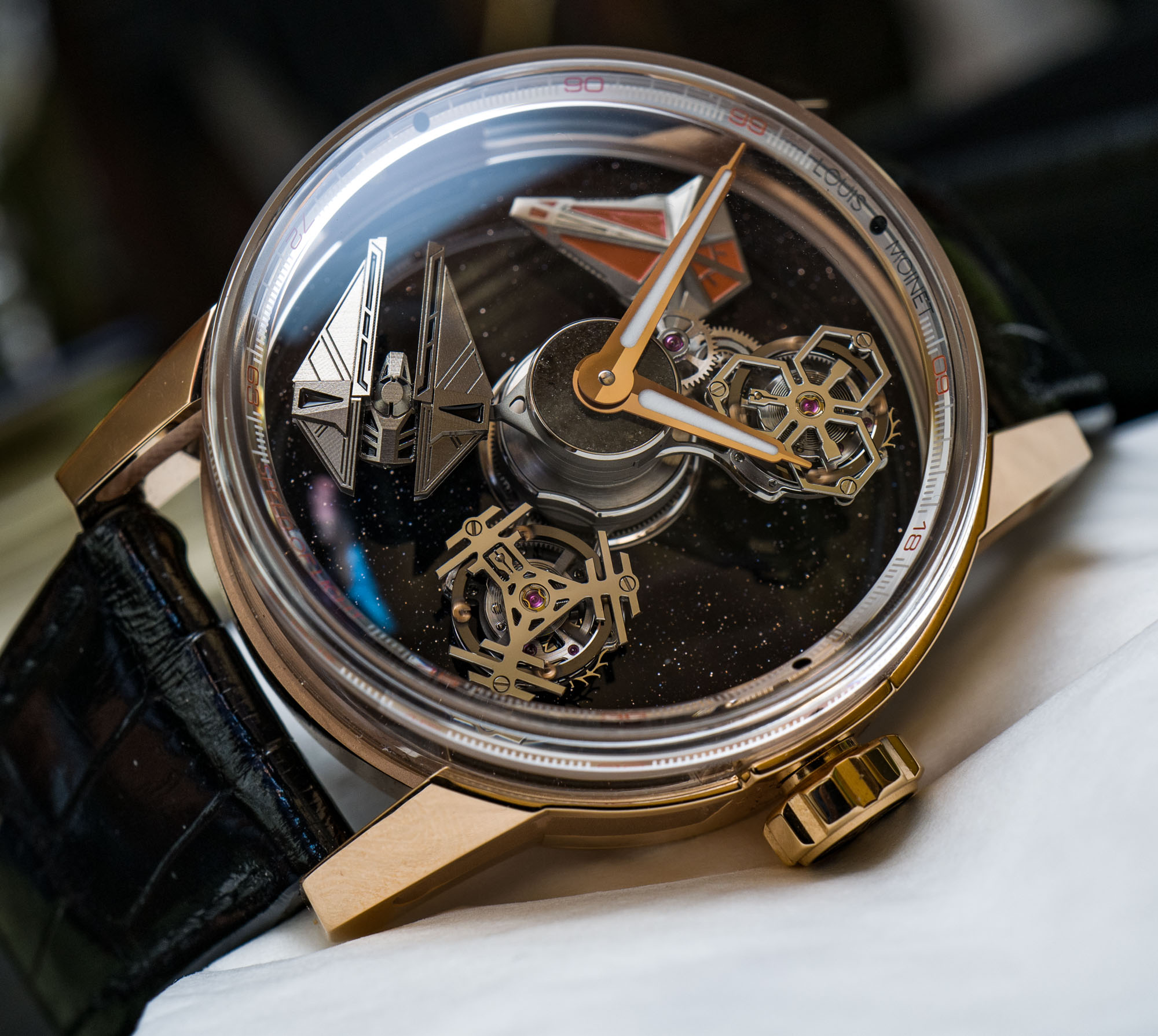
Space Revolution is an encouragement to go beyond boundaries. As you know, I have a strong interest in developing cosmic art. Recently, I met with my friend Florian, who is also a world specialist in terms of flown materials. We discussed for a long time, and I selected amazing pieces related to the most important space missions to date. At the same time, my son found an original watchmaking treatise (1848) from Louis Moinet, with a handwritten page from Mr. Moinet himself.
All these are pieces of a jigsaw puzzle that I put together, day after day. It has been now 20 years that I restarted Louis Moinet from a blank sheet. Today, I am very very happy to see that our Moon and Mars collections quickly sold out. It means that our friends and customers are appreciative of our Art. You see, my goal was never to become an important maker in terms of quantity, but to remain an artisan creating as much value as I possibly can. Learn more at the Louis Moinet website here.

